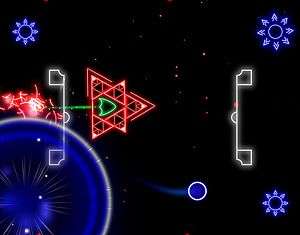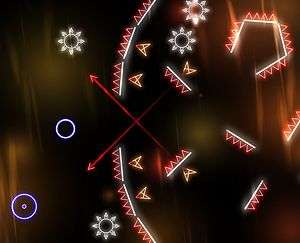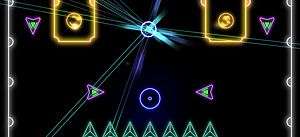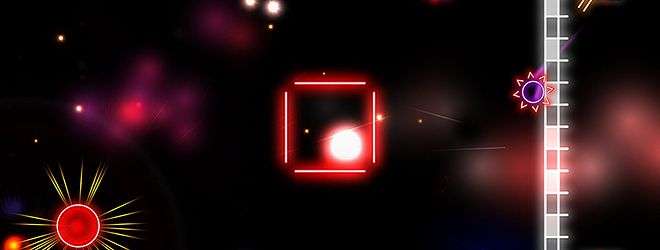Ellipsis – Review
by Chris
|
 Ellipsis is described as a ‘minimalist game’, which is noticeable pretty much throughout this charming little sci-fi themed mobile game. Debuting on Android systems as recently as May 2016 but enjoying success on iOS platforms for much longer, Ellipsis has a quirky way about itself that features plenty of interesting design choices that I enjoyed here, and now miss from other titles.
Ellipsis is described as a ‘minimalist game’, which is noticeable pretty much throughout this charming little sci-fi themed mobile game. Debuting on Android systems as recently as May 2016 but enjoying success on iOS platforms for much longer, Ellipsis has a quirky way about itself that features plenty of interesting design choices that I enjoyed here, and now miss from other titles.
The minimalist approach, as it is described, is what hooks me right from the off. You literally just start playing from the moment you load the game. Presented with a blue sphere on screen, you push your finger of choice into its inviting centre and the level begins. There is no story, no contrived tutorial, and no guidance – you just play.
So few games do this and instead focus on telling you how to gain maximum enjoyment. I gained maximum enjoyment with Ellipsis by trying to decipher its world map. After every level, a bright smorgasbord of neon shapes and sharp movements meant that there was clearly a bigger story being told here, and I was looking forward to each new piece I would unlock with every completed stage. Mostly, these new pieces would be tiny parts of a bigger picture but on occasions, huge chunks would be revealed, depicting walls, armies, guards, territories – it’s hard to explain in words but looking at the screen shots won’t do it justice either.
The gameplay revolves around you collecting orbs in each level. The start of the level will feature minimal threats and you’ll guide yourself to the first couple of orbs with ease. There are five on each level, and each orb contains smaller orbs inside. The first orb has one smaller orb, the second orb has two, and so forth. Your basic requirement is to collect four orbs – this is, generally speaking, fairly straightforward. The difficulty comes as every time you touch an orb, the smaller orbs inside can be but don’t have to be collected. They represent gaining more stars and therefore a greater mark of success on that particular level. The problem is that once you touch the outer part of the orb, the smaller orbs inside start floating around like little neon children that have necked a bottle of Calpol. Their motions aren’t violent; they just drift around, minding their own business.
 Meanwhile, you’re trying to dodge certain death from the one-hit-kills enemies that inhabit the levels. Collection is further hampered whenever you touch one of the five orbs because it causes new enemies to appear. I didn’t mean the fifth orb did I? You only need four orbs to exit the level. That fifth one is purely optional but if you want to hit higher ranks on the leaderboard or you think you’ve got mad orb-collecting skills, you’ll want to go for it. The enemies trying to stop you are a pretty standard bunch – things that shoot, things that track, and things that move around in a set pattern. As the levels progress you’ll need to activate switches, avoid attacks, and work out what to do with very little to no input. It’s rewarding and refreshing having pretty much all of the onus of learning placed on the player.
Meanwhile, you’re trying to dodge certain death from the one-hit-kills enemies that inhabit the levels. Collection is further hampered whenever you touch one of the five orbs because it causes new enemies to appear. I didn’t mean the fifth orb did I? You only need four orbs to exit the level. That fifth one is purely optional but if you want to hit higher ranks on the leaderboard or you think you’ve got mad orb-collecting skills, you’ll want to go for it. The enemies trying to stop you are a pretty standard bunch – things that shoot, things that track, and things that move around in a set pattern. As the levels progress you’ll need to activate switches, avoid attacks, and work out what to do with very little to no input. It’s rewarding and refreshing having pretty much all of the onus of learning placed on the player.
Exiting the level is a simple case of guiding your sphere to the entrance that appears once you have gathered the first four orbs. That being said, you’ll always try and go for the fifth one because you want to see if you can do it. The game is bolstered by a Super Meat Boy style restart should you die, meaning you’re never away from the action for too long.
Where the game excels is its graphics and some of the interesting design choices. First off, this is not a free title and I paid around two pounds fifty for it. For that, I’m not impeded by any life restrictions or pauses to wait for gameplay; I can simply get on and play. So many mobile games make the mistake of being free and then harassing the player with micro-transactions. Next are some of the settings, whereby you can choose how you move your sphere round the screen, either by pressing down on it or by pressing down on a portion of the screen and guiding it from there. I have seen this in a couple of others titles but it’s actually quite important here, because I found myself switching between control styles depending on the layout of the levels. The fact that this change was done in a couple of clicks and didn’t require me to exit the level I had started was a welcome addition.
The second area where the game excels is the graphics, to the point where I was actually grinning at certain points when things changed or appeared. The red neon glow of the enemies is vivid and vibrant, letting you know that these things are bad and you should stay away from them. Your sphere and the orbs you collect are always a welcoming blue, so you always know where you want to be heading. The graphics, like the game, are minimalist but it all just works really well. It’s also kind of cool that on occasions the graphics will change when you’re going for that fifth orb. Maybe you’ll have some blurring or what looks like lens flare coming off the neon enemies. Using the graphics to highlight a change in difficulty is a very, very clever feature.
 The audio, again, can be described as minimalist but again it just works. You get some light music in the background; nothing grandiose or heart-stopping but pleasant nevertheless. There are subtle noises for when you die, complete a level, collect orbs, and the odd enemy attack, but aside from that it is pretty quiet. This isn’t a bad thing, and the game doesn’t need to be going over the top with regards to its sound because of the quality elsewhere.
The audio, again, can be described as minimalist but again it just works. You get some light music in the background; nothing grandiose or heart-stopping but pleasant nevertheless. There are subtle noises for when you die, complete a level, collect orbs, and the odd enemy attack, but aside from that it is pretty quiet. This isn’t a bad thing, and the game doesn’t need to be going over the top with regards to its sound because of the quality elsewhere.
I’ve sunk a good number of hours into Ellipsis and I continue to enjoy the differences to each level and the unlocking of the bigger ‘world’ map. The stars you collect can be compared to others on a leaderboard but this may not be for everyone. I would have liked to see (and may yet uncover) some other elements such as the ramping up of the challenge or a survival mode. These aren’t essentials though; the base game keeps you busy enough and the core content mixes things up often enough that it feels fresh to me after a period of time with it. My only recommendation, rather than a criticism, is that it might be better enjoyed on a bigger screen. I was playing on an LG G3 and occasionally I ran out of room to move my sphere with. So this is something to remember, should you find yourself getting frustrated with the game on your Sony Xperia Z5 Compact.
Pros- Minimalist approach works
- Gameplay is fun and challenging
- Not a micro-transaction in sight
- Cool graphical elements
- Might be better played on a larger screen
- More modes would flesh the game out better
Ellipsis is an interesting little game. You’d be forgiven for thinking its minimalist approach means you’re getting an inferior game, but this couldn’t be further from the truth. Instead, Ellipsis is a lovely little title that has some great ideas, uses them well, and comes off as original and fun. It’s a game I’ll be sticking for a good while. If nothing else, Ellipsis perfectly captures one well-worn phrase – ‘less is more’.
Last five articles by Chris


























There are no comments, yet.
Why don’t you be the first? Come on, you know you want to!